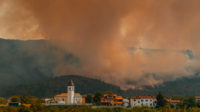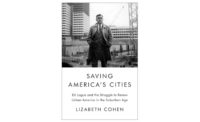Fixing, to fix—included in the title of this book—is a striking word and concept within architecture, planning, and design. In certain contexts, to fix means to repair; in others, to fix is to make firm, to establish.
Douglas Kelbaugh, architect, planner, and former dean of the Taubman College of Architecture and Urban Planning at the University of Michigan, is not new to fixes. His first completed building was a 1975 passive solar house with a trombe wall—a design spurred by anxieties concerning the limits of oil and the limits to growth. As he investigated larger-scale solutions to such limits, he wrote Repairing the American Metropolis, among other books on similar topics.
In The Urban Fix, Kelbaugh argues that cities are a frontline in the “war” against climate change, and need to be reoriented through urban planning and design. In doing so, he reviews current research on climate change—a large inventory of frightening probabilities that will be familiar to many readers. Kelbaugh then passes over scores of strategies that would provide respite from the hot days ahead. The book’s sprawling attempts—each well-intentioned if inadequate—provide one indication of the immense complexity of the problems we face.
The book is particularly concerned with “urban heat islands”—how to relieve the excessively high temperatures caused by the tendency of urban centers to trap heat within their built fabric. Addressing the problems of these sites suggests, for Kelbaugh, a way to attack the huge, looming problem of climate change at a scale that seems meaningful. He discusses well-known palliatives like green or white roofs, as well as lesser-known studies demonstrating, for instance, that complicated street patterns dissipate heat better than linear ones. Another chapter is devoted to urban tree planting, which, in addition to reducing ambient heat also—according to one study cited—lowers levels of street crime.
This last claim evokes older, top-down planning strategies that echo throughout the book, solutions that might render the city stable, manageable, and beautiful once again. But environments and ecologies, social and natural, interfere with such clear-cut approaches. An urban tree is not a discrete entity: it is a regionally specific species and a part of an ecological system; it is a shading device; and it is an instantiation of spatial and social and class disparity, among many other things.
Fixing is the problem. In much of the wealthy world, particularly in America, we are fixed in place by highways, by poor public transport, by energy-intensive and fuel-hungry buildings—themselves stitched together, in their seams and sealants, from the fantastic surpluses of petroleum processing. The tension between such fixes confronts us. It is hard to fix the problem when the problem is itself so fixed.





